#TBT Going Hands-on With the Seiko 7C46 Golden Tuna
If you’ve been following #TBT, and Fratello Watches for that matter, for any length of time, you’ve undoubtedly noticed that we’re huge fans of the Seiko Tuna series of watches. Whether reading Gerard’s history of the watches or sifting through any number of model-specific articles, our admiration runs deep for these oddly shaped, but distinctive divers. And so, today, it’s with somewhat of a bittersweet feeling that we’ve come to the end of our journey on vintage “true” Tunas with a look at one of the brand’s most successful and popular variants, the Seiko 7C46 Golden Tuna. Don’t fret, we’ll be back with more love for the shrouded beasts, but those articles will focus on the slightly less pure versions. Let’s take a look at the last of the vintage Tunas, but before we do, a recap is in order – and this includes vintage and modern.
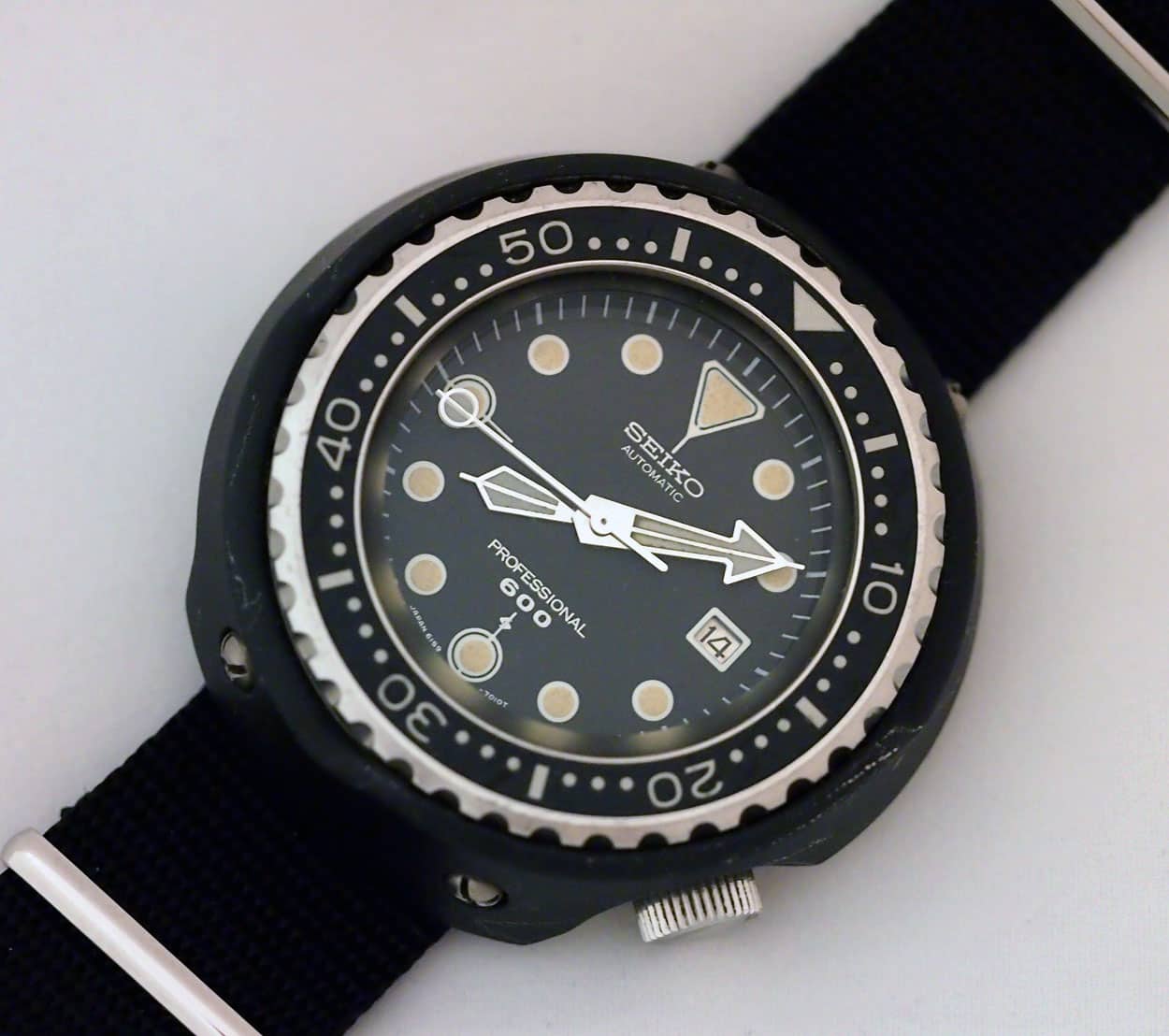
The 6159 “Grandfather Tuna”
Introduced in 1975, the groundbreaking 6159 “Grandfather Tuna” introduced the shroud as we know it today, brought full titanium construction, a hi-beat movement, and 600M of water resistance. I wrote about it in one of my earliest articles with Fratello and Robert-Jan detailed his a couple years later. This watch was in production until roughly 1979.
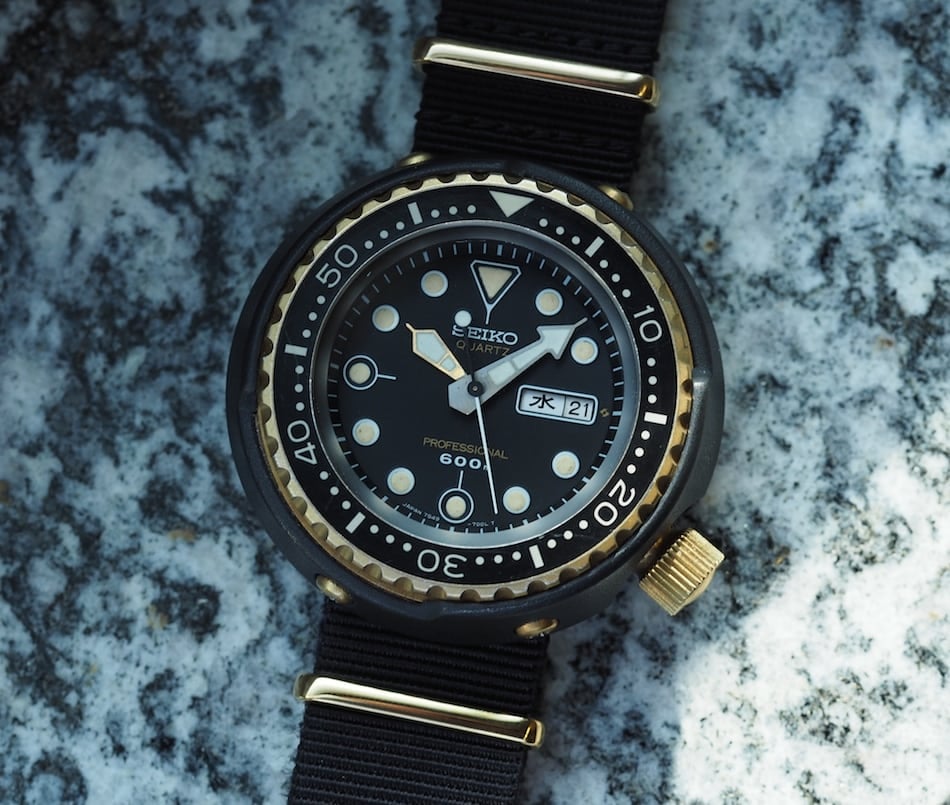
The 7549 “Golden Tuna”
In an ongoing quest for the ultimate in precision timekeeping, Seiko announced the 7549 Golden Tuna in 1978. With a quartz movement, this new Tuna became the first professional diver running with such a heartbeat. Sound boring? It wasn’t in 1978 and cost 50% more than the 6159! It shared the same 600M depth rating as its mechanical counterpart, but brought in the gold titanium nitride coated case that we’ve come to enjoy so much from the brand. This watch was in production until roughly 1985.
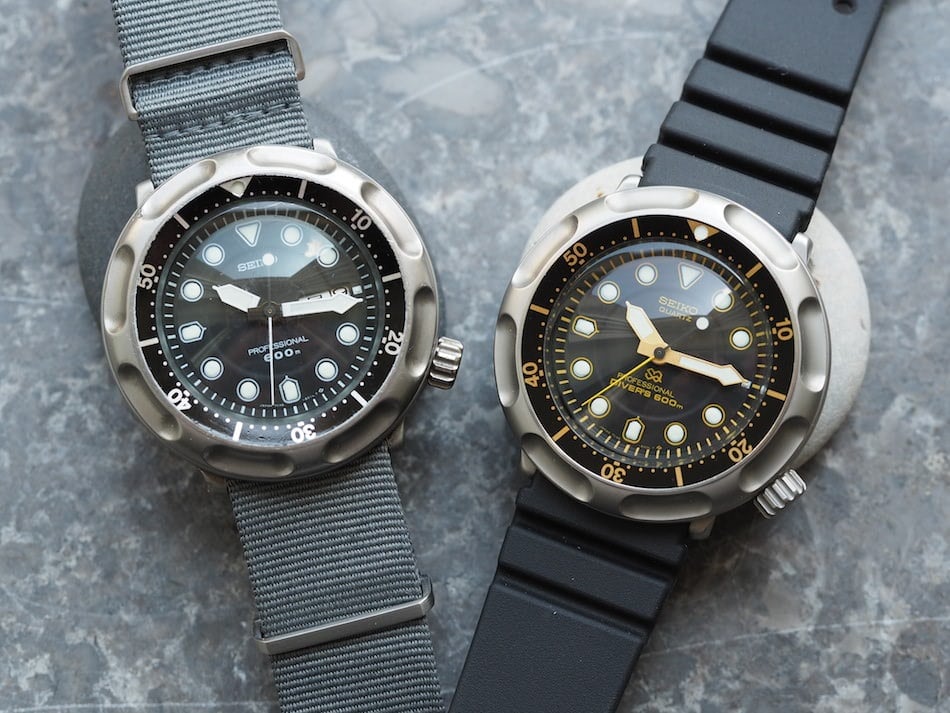
The 7C46 “Ashtray” Series
Some would take issue with us listing the 7C46-6009/10 series, better known as the “Ashtrays” due to their distinctive scalloped bezels, within the Tuna framework, but collectors often consider these professional divers as family members despite the screw-down case back. Introduced in 1986 and in production through the early 90’s, these are relatively rare beasts. The -6009 comes in stainless steel while the -6010 is cased fully in titanium. These amongst the most distinctive divers from Seiko, but with 600M of water resistance, they’re far more than just a, erm, pretty face.
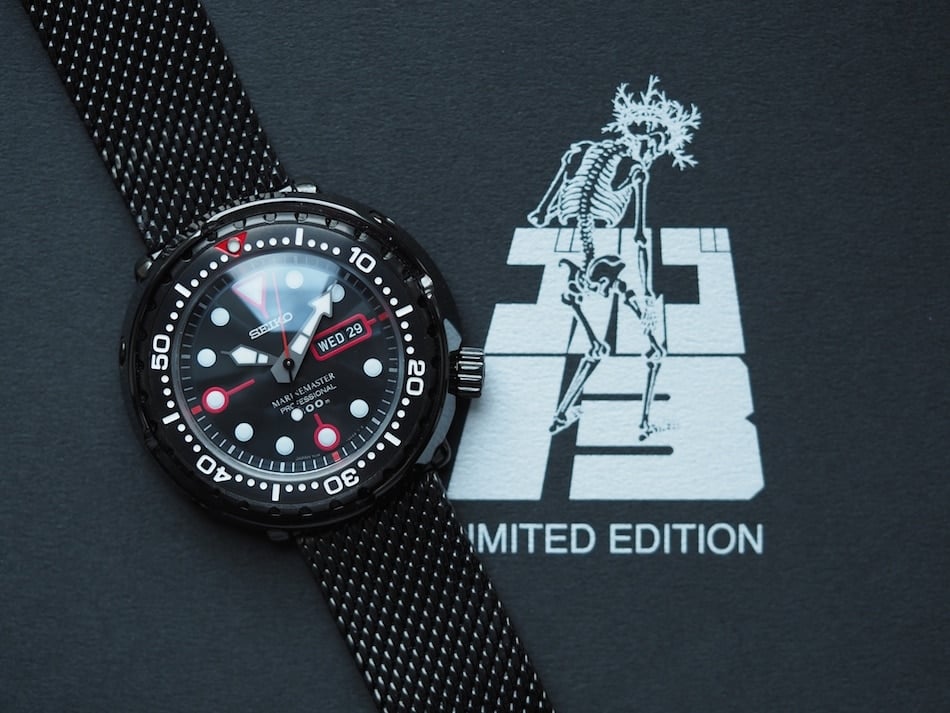
The 7C46 Marinemaster Professional 300
Coming to the more modern Tunas, we took a look at one of the more popular models, the Marinemaster Professional 300. These feature shrouds, but also a screw-down caseback, so many consider these to be a “light” version of the species. Still, they’re highly wearable and the same model has been around since the mid-80’s with few changes aside from different case and bezel variants and a change in hands several years back to Seiko’s new, albeit controversial, theme. Specifically, we reviewed an all black limited edition model commemorating the Japanese Manga character “Duke Golgo” from Golgo 13.
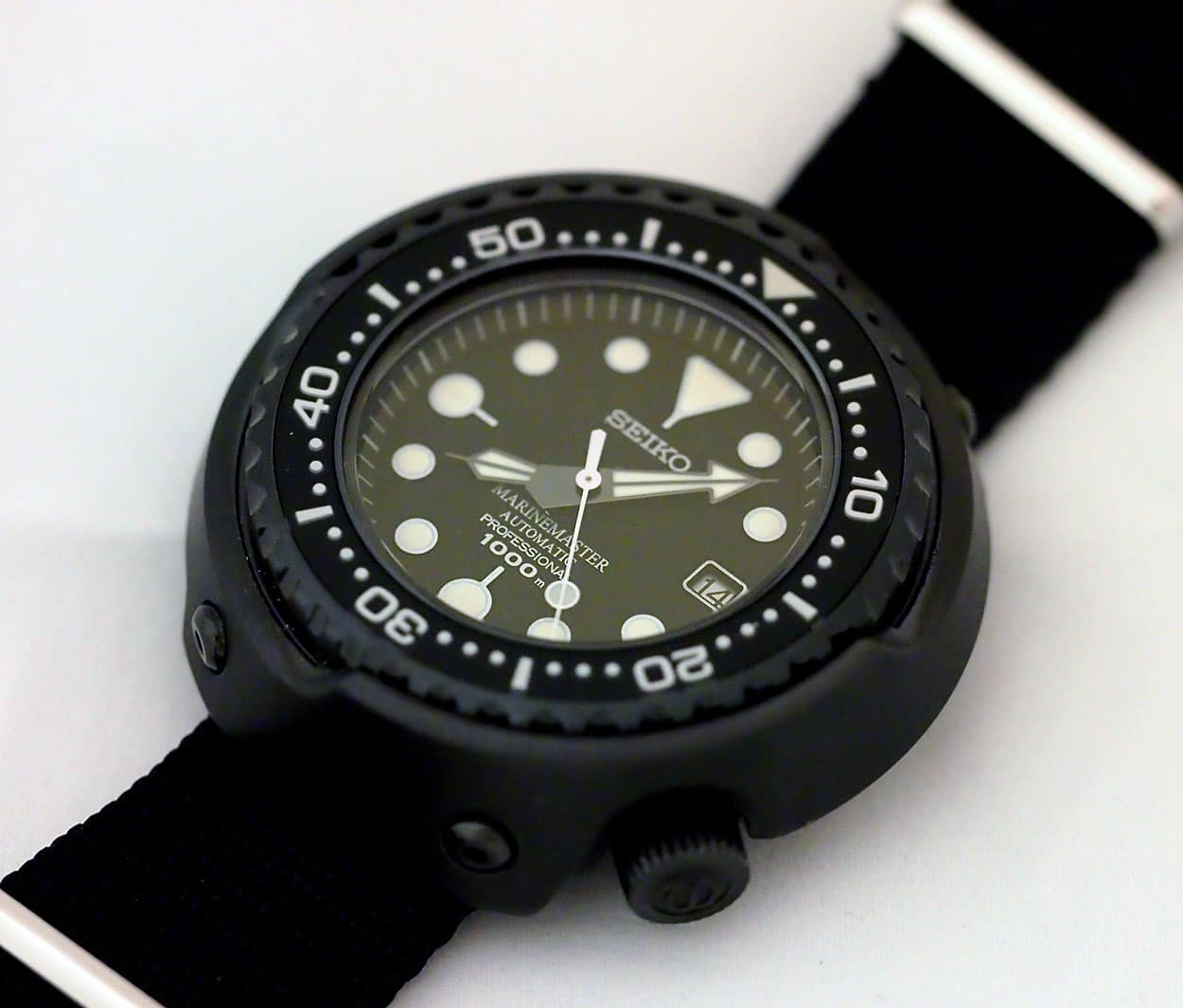
The SBDX011 “Emperor Tuna”
For 2009, Seiko finally answered the bell with the reintroduction of a mechanical Tuna in the form of the SBDX011, otherwise known as the “Emperor Tuna”. It’s a massive, menacing watch at 51mm and done all in black, and it contains some amazing specs. Titanium construction, 1000M of water resistance and a detuned Grand Seiko 9S55 movement are just some of the goodies. The same watch is essentially on offer today, but with an updated shroud and the aforementioned newer hands. Personally, I like this piece with the traditional hands and it seems collectors agree as prices are slowly rising.
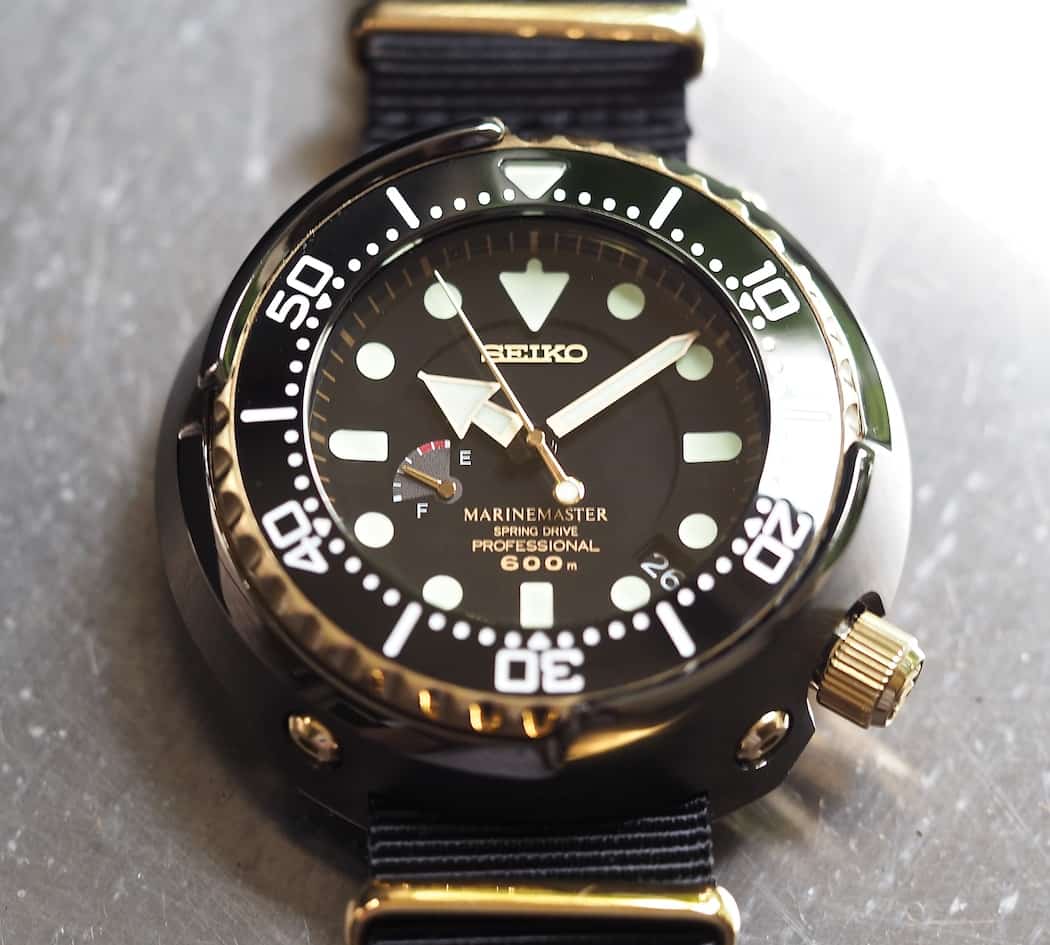
The SBDB008 Spring Drive “Golden Tuna”
The latest variant of Tuna comes to us from 2013 in the form of a Tuna with a Spring Drive movement. Prior to the release of an all black reular production version of this watch in 2014, Seiko decided to launch the idea with a limited edition (only 300 made) Golden Tuna version. The watch was and is significant for a couple reasons. Namely, it was the first time the Spring Drive movement had been placed into a shrouded case and it also introduced the polarizing new handset. The Spring Drive Golden Tuna brings a wild movement, titanium, ceramics and ridiculous lume to the party and charges a hefty premium in the process!
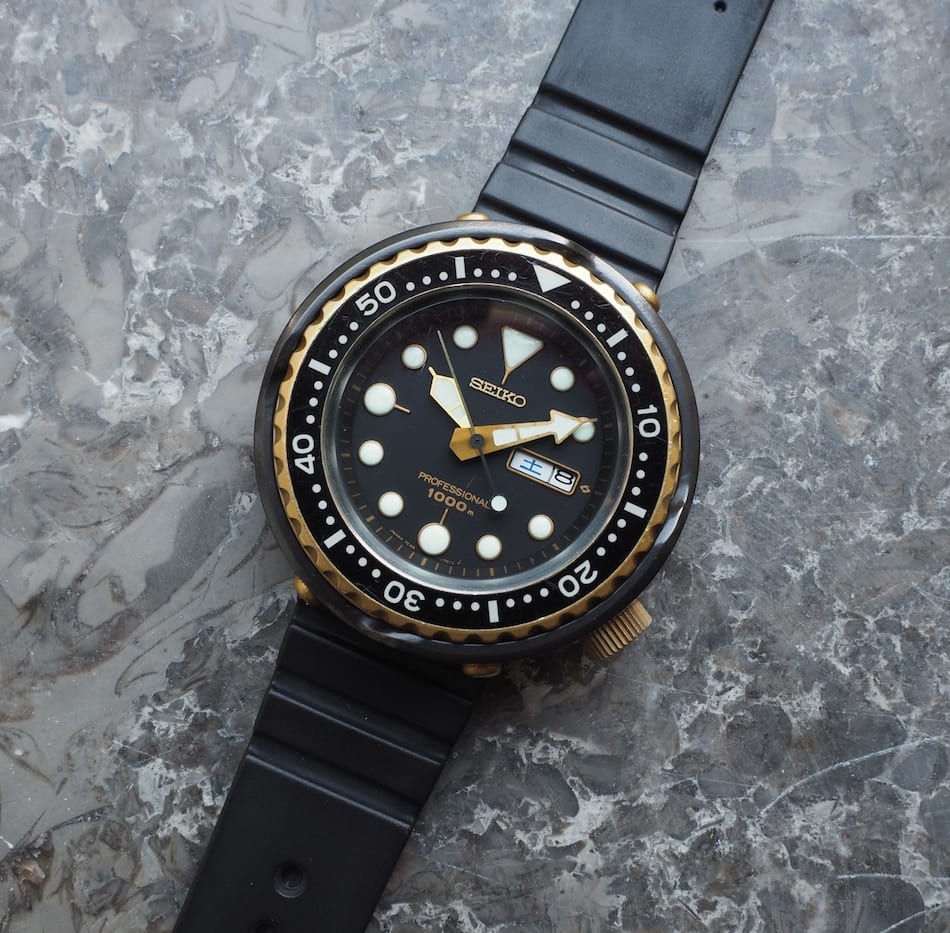
The Seiko 7C46 “Golden Tuna”
Now that we’ve taken a trip down memory lane, let’s come back the focus of our article, the Seiko 7C46 Golden Tuna. In 1985, Seiko brought the world the ultimate expression of its professional diver and decided to house it within a monobloc-shrouded case. In what probably seems blasé today, the brand debuted a brand new movement with the 7C46, paired it with a gold titanium nitride-coated main case, and upped the ante with a crazy 1000M of water resistance. The new movement came with an impressive 5 years of battery life and gave the user fair warning that it was time to replace the battery when the seconds hand began to jump 2 seconds instead of the typical 1.
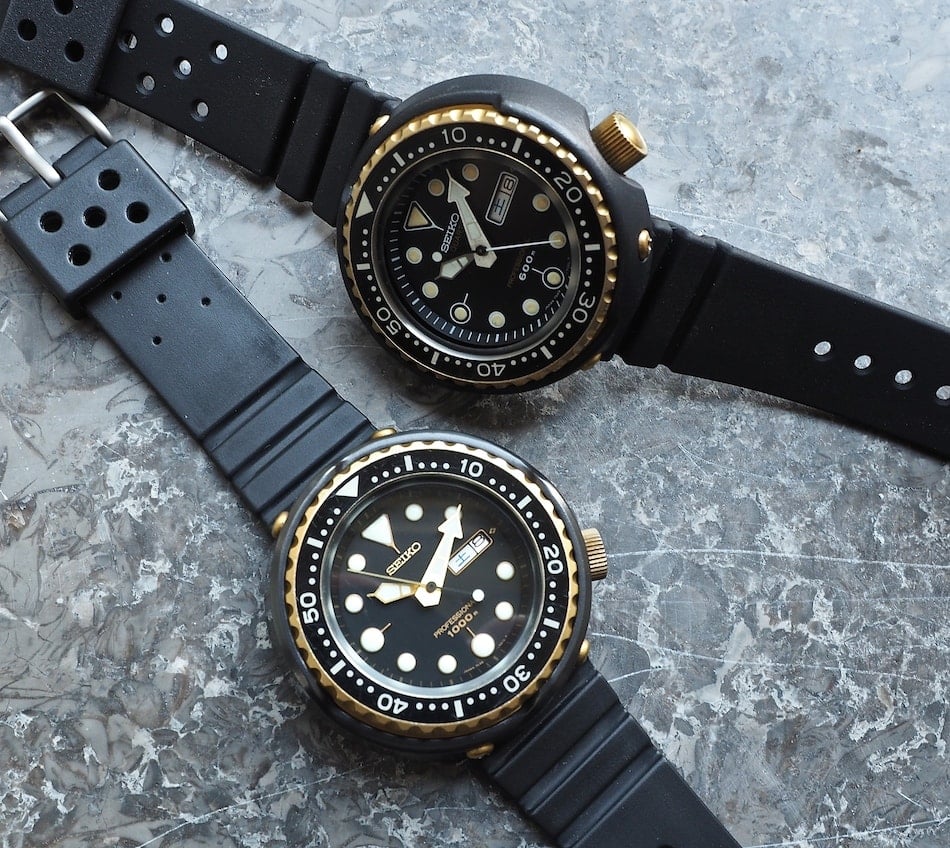
Other typical Tuna traits carried on with the Seiko 7C46 Golden Tuna such as the hallmark L-shaped gasket, Hardlex crystal, flat-vented rubber strap, lume-filled plastic inlay bezel, unidirectional bezel, and a quickset day and date. The watch grew slightly over its 7549 predecessor (49.6mm diameter vs 49mm) and its height is a robust 16.1mm. Lug to lug is somewhere around 50mm, so it truly fits within the definition of a tuna can.
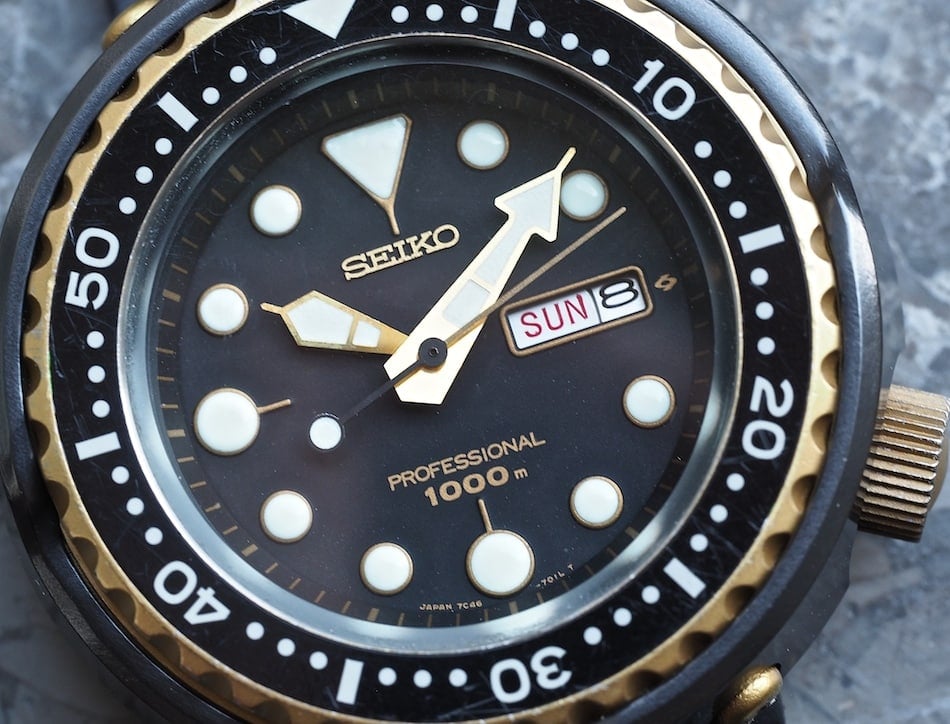
The dial of the Seiko 7C46 Golden Tuna features improved lume when compared to the prior generation of watch. Instead of what looks like a thin layer of glowing material on the 7549, the 7C46 brings thick, slightly blobby and sloppy expanses of the stuff into thin-bordered hour markers. The printing on the black dial of the 7C46 shows some improvement as well. It’s done in the same gold ink that forms the crosshairs extending from the markers at 6/9/12. All told, it’s a more modern look that suits a watch that was made until the early 2000’s. The hour and minute hands keep their traditional shape, but are gold in color this time versus steel. The sweep hand maintains the lollipop of lume look on its back end, which is a “tell” to the Seiko faithful that a quartz heartbeat likely lies within. You’ll also see the wonderful little Suwa symbol to the right of the date window, a nice vintage touch that would continue on through the 90’s.
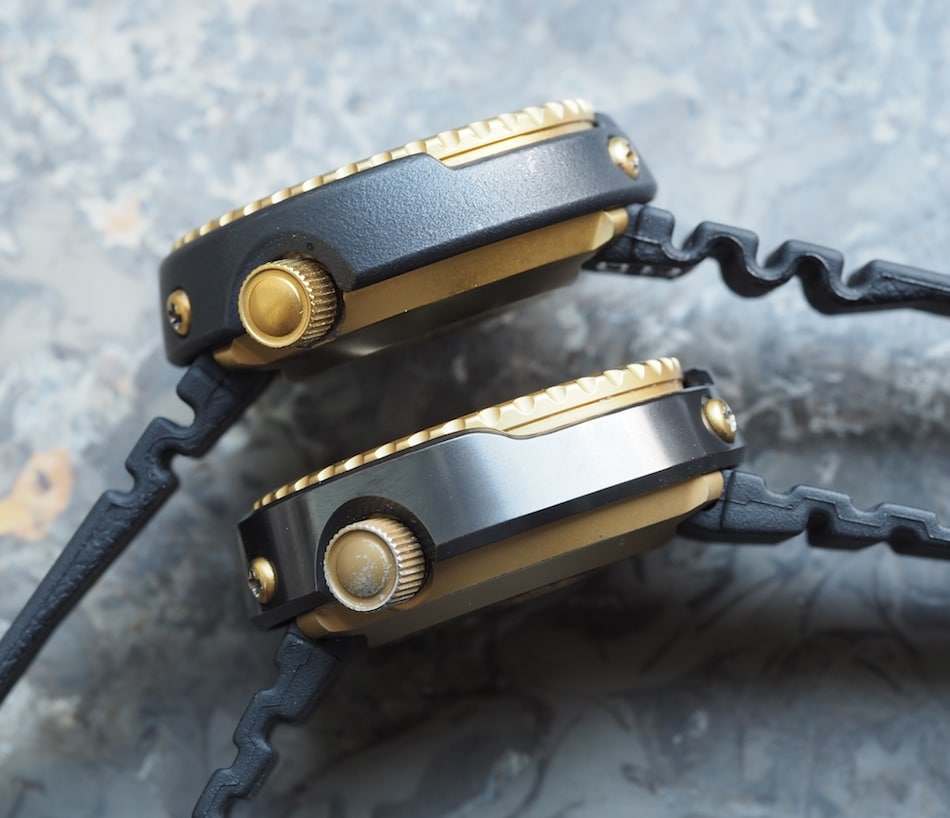
As mentioned, the Seiko 7C46 Golden Tuna used smooth, black zirconia for its shroud. The original 6159 used a rough-finished ceramic that was prone to chipping while the 7549 employed powder-coated titanium. The smooth 7C46 feels silky smooth by comparison, but is also known to chip if the impact is blunt enough. It’s definitely more of a modern look, but I can’t help prefer a bit more texture to my shrouds.

Still, one can understand that Seiko was intent on implementing more advanced materials on their top grade watches. A look from the side also shows us that the crown on this watch has lost some of its gold nitride coating, thereby exposing stainless steel underneath. It’s a fairly common occurrence on these Golden Tunas as sweat and oils start to attack the finish.
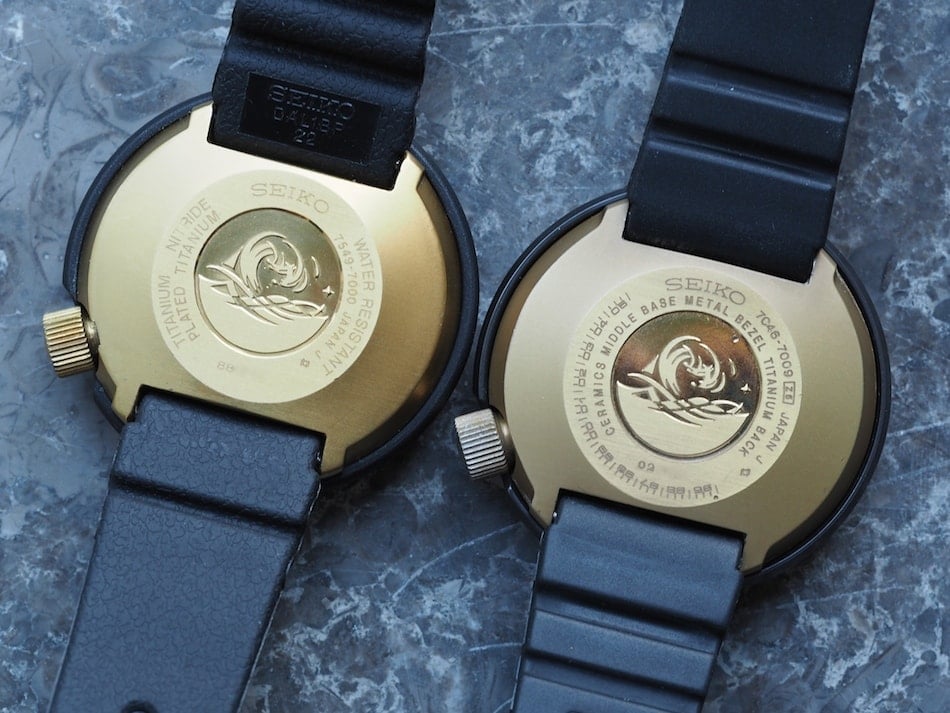
A look at the case back of the Seiko 7C46 Golden Tuna brings the familiar Tsunami logo to the center along with the addition of a meter showing us years in chronological order. You’ll spy a small marking just before 1986 and that denotes a battery change should’ve been performed sometime in 1985. The watch was produced in February of 1990 (the “0” and “2” are visible while I’ve obscured the rest of the serial number), so that makes sense with roughly 5 years of battery life on the 7C46. Versus the preceding 7549 models, the 7C46 also carries a lot more materials information. We see the ceramic shroud, a base metal bezel and a titanium case back are listed; a real curious mix of low and high tech!
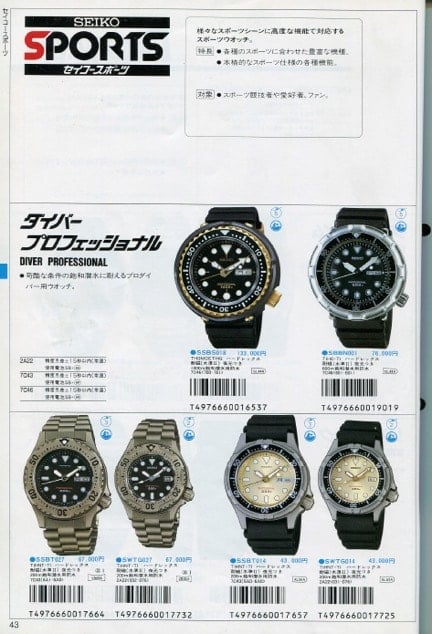
A Seiko catalog picture from 1996 (courtesy of thewatchsite.com)
The 7C46 that we have here is a -7009 variant, which makes it a Japanese market version. While I don’t show it here, it does contain a Japanese/English day wheel. Introduced in 1985, this exact model still showed in catalogs as late as 1998 (I’ve been unable to find 1999 and 2000 catalogs at the time of publishing), but most feel that it was produced until 2000. During this time, a similar -7010 version was also produced for the rest of the world and differed slightly with the use of the “SQ” Seiko Quartz logo on the dial. Coming back to the -7009, I looked at Seiko catalogs from the beginning of production (’85) all the way through ’98 and the price remained steady at a strong 133,000 Japanese Yen. I took a look at the US Dollar exchange rate and this was equal to about $925 in 1990 and $1250 by 1996, so this wasn’t a throwaway piece. Finally, in 2000, a -7008 variant replaced the -7009/7010 and brought slightly different hands to the game and confusingly both the JDM and rest of world version “SQ” shared the same reference number. Sadly, the Suwa symbol disappeared from the dial for good. This model was made until roughly 2006.
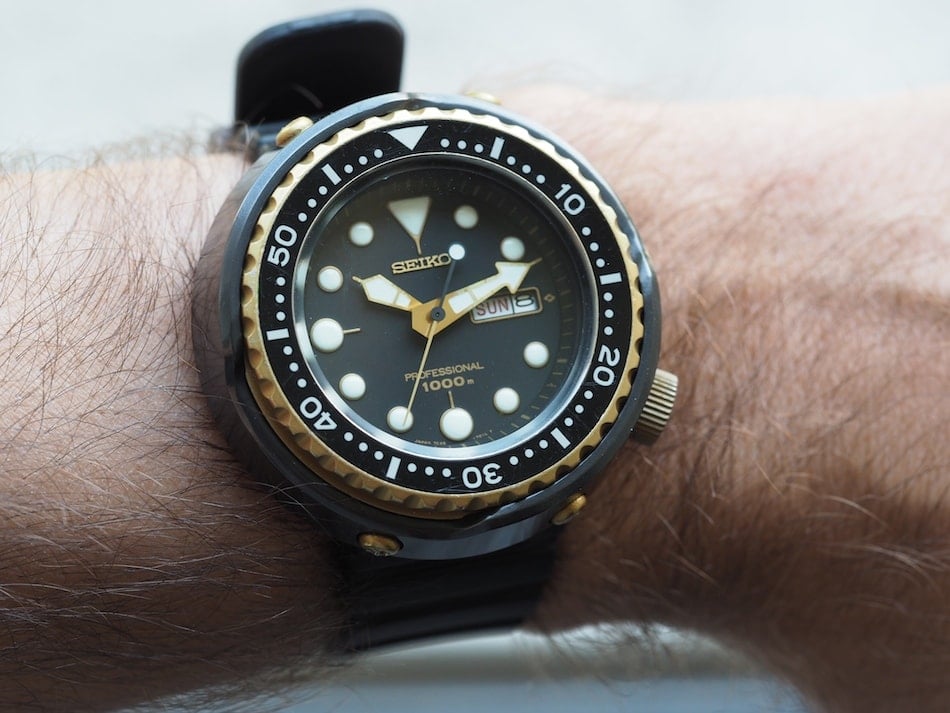
The Seiko 7C46 Golden Tuna fits like any Tuna and that means that it’s tall, but relatively compact. I vacillate on whether or not to wear my Tunas on vented rubber straps, but that’s an improvement because I used to go exclusively with NATO’s. In this case, the watch is paired with an aftermarket “Bambi” strap from Japan that mocks the real Seiko strap, but is actually far more pliable and comfortable. By the way, I do need to look for a gold titanium buckle to make things more complete. Speaking of looking, if you’re on the hunt for a 7C46-powered Golden Tuna, be prepared to shell out anywhere from $1200–2000 depending on condition and region of sale. Sometimes, these pieces go for surprising sums and sometimes they fall flat and can be bought for a song. I guess that’s the world of quartz, but many savvy Seiko collectors consider this their favorite of the vintage Tunas because of the golden looks and the nearly bulletproof movement (which, as I recently learned, is easily and cheaply repaired by Seiko).
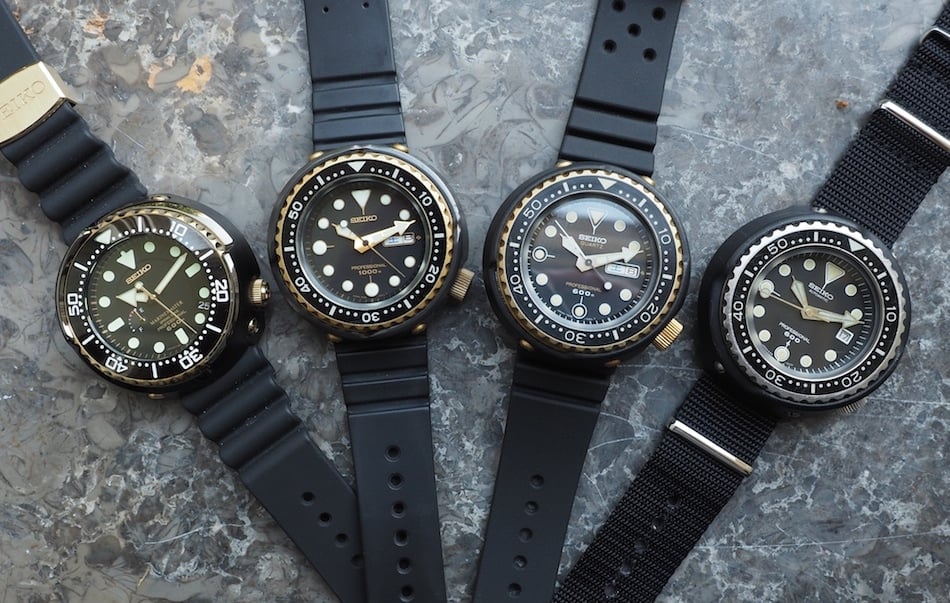
As I mentioned, we aren’t done with reviewing vintage shrouded pieces, but the Seiko 7C46 Golden Tuna is the last in-depth stop on our tour of retired true Tunas. After picking up the 7549, I wasn’t sure that I “needed” a 7C46, but the subtle differences in materials and design led me to adding one to the fold. It’s a worthy specimen to collect and could easily work as a daily watch with its modern (read: still in heavy production) movement. Until next time…













